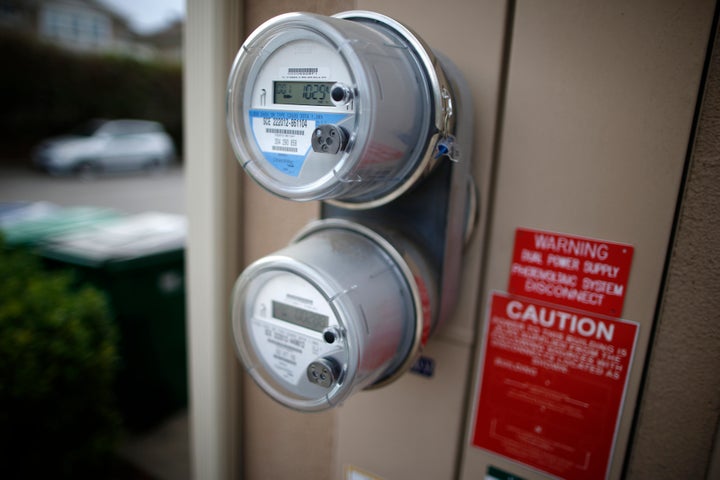
We’re still pretty far from modern cities being truly energy-efficient ― when sun and wind can power entire metropolitan areas, bullet trains whisk commuters hundreds of miles in an hour, and affordable electric cars and self-driving vehicles make fossil-fuel-powered rides obsolete.
A few of these advances are beginning to creep out: We’ve all seen the flashy headlines about Uber testing its autonomous cars in three United States cities, and reports that California is considering a ban on gas-powered cars. But a subtler, less flashy future of efficient cities is already here, and it’s come in the form of the Internet of Things. That term refers to everyday objects connected with software and sensors that allow them to pick up data on their surroundings or exchange information with other devices.
Whether you knew it or not, there are already sensors that are rigged up to water and electricity meters, so a human doesn’t have to knock on doors to ask residents for their meter levels, or an area water system doesn’t overwater a park when it has already rained. Instead, these sensors, in the form of smart thermostats, smart water meters and smart lighting systems, can monitor how much of a resource is being used, and correct their own behaviors according to what’s needed, in real time.
An estimated 65 million smart electricity meters are installed in homes across the U.S., making up half of all American households. Smart water meters were installed in California cities such as Long Beach, San Diego and San Francisco to curb the state’s drought, and have made their way to households in many other cities, including Washington, D.C.; Bellevue, Washington; and Santa Fe, New Mexico.
The Internet of Things could be an $11.1 trillion market by 2025, according to consulting firm McKinsey. Systems like smart meters, which are expected to reach some 90 million U.S. households by 2020, could help people save on energy costs.
“Their selling point to consumers is that they end up paying for themselves,” says Joshua New, a policy analyst with the Washington-based Center for Data Innovation, a think tank that focuses on technology and public policy. “A lot of the [clean energy] benefits are going to come from widespread adoption of relatively mundane technologies.”

Barcelona, for example, a city that was hit hard by the 2008 economic recession, has already seen measurable benefits from these quiet changes. It launched its Smart City Barcelona initiative in 2011, and over the next few years installed smart water meters for city green spaces and sensors for rain and humidity levels, cutting water usage about about 25 percent and saving the city $58 million on annual water costs. ApparkB, Barcelona’s smart parking system, uses sensors to notify drivers of available spots, cutting their carbon emissions and increasing municipal parking revenues by $50 million a year. More than 1,100 city lampposts switched over to LED lighting by 2014 -- the posts also have WiFi, because why not? ― to cut lighting costs by 30 percent each year.
While revamping a city’s whole infrastructure system would call for huge investments, adopting smart technology is a lot cheaper and easier, and people see the benefits right away.
“It’s the replacing of the everyday, normal objects with smart devices that I think will be the game changer” when it comes to energy efficiency, says New.
Some cities are using connected devices to collect information about the environment.
In Chicago, the Array of Things project posted hundreds of sensors at intersections all over the city to track temperature, air pollution, traffic congestion and noise. The project is meant to serve as a “fitness tracker” of sorts for the city and will potentially change traffic routes in response to jams. The project is expanding to more U.S. cities in the next few years, including New York, Portland and Atlanta.
Seattle has begun to use sensors on some traffic lights to adjust their timing according to traffic flow in real time, and cities such as Dublin and Copenhagen have even been using smart garbage cans that track their own levels of waste and notify the network when they need to be emptied.
In the near future, urban technology experts say sensors will even be used to make buildings responsive to the people that occupy them.
For those who shiver daily in the bone-chilling cold of their office AC systems (Ladies, am I right?), one solution may come in the form of a personalized climate, says Carlo Ratti, an architect and engineer and the director of MIT’s SENSEable City Lab. Ratti’s own architecture firm has outfitted the Turin, Italy, offices of the Agnelli Foundation with a system of sensors allowing people to create a climate “bubble” that will follow them around wherever they are in the building.
“We think it could be the end of the thermostat wars that traditionally happen indoors,” Ratti said.
After a person sets his or her desired temperature and lighting levels on their mobile phones, the “bubble” will be activated from the ceiling, and if there are differing temperatures requested in a group of people, the building will use the average.
“It’s like FourSquare, inside the building,” Ratti says. “We can measure occupancy in buildings in real time. The interesting thing is that the building can respond automatically.”
Sensors might one day gather data on garbage trucks and even sewage, to track the presence of environmental pollutants, bacteria and viruses.
“We may be able to find epidemics before they happen,” Ratti says.
